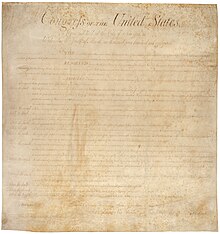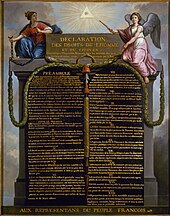Freedom of religion is a principle that supports the freedom of an individual or community, in public or private, to manifest religion or belief in teaching, practice, worship, and observance without government influence or intervention. It also includes the freedom to change one's religion or belief.[1]
Freedom of religion is considered by many people and most of the nations to be a fundamental human right.[2][3] In a country with a state religion, freedom of religion is generally considered to mean that the government permits religious practices of other sects besides the state religion, and does not persecutebelievers in other faiths. Freedom of belief is different. It allows the right to believe what a person, group or religion wishes, but it does not necessarily allow the right to practice the religion or belief openly and outwardly in a public manner.
Historically, freedom of religion has been used to refer to the tolerance of different theological systems of belief, while freedom of worship has been defined as freedom of individual action. Each of these have existed to varying degrees. While many countries have accepted some form of religious freedom, this has also often been limited in practice through punitive taxation, repressive social legislation, and political disenfranchisement. Compare examples of individual freedom in Italy or the Muslim tradition of dhimmis, literally "protected individuals" professing an officially tolerated non-Muslim religion.
In Antiquity, a syncretic point of view often allowed communities of traders to operate under their own customs. When street mobs of separate quarters clashed in a Hellenistic or Roman city, the issue was generally perceived to be an infringement of community rights.
Cyrus the Great established the Achaemenid Empire ca. 550 BC, and initiated a general policy of permitting religious freedom throughout the empire, documenting this on the Cyrus Cylinder.[4][5]
Some of the historical exceptions have been in regions where one of the revealed religions has been in a position of power: Judaism, Zoroastrianism, Christianity and Islam. Others have been where the established order has felt threatened, as shown in the trial of Socrates in 399 BC or where the ruler has been deified, as in Rome, and refusal to offer token sacrifice was similar to refusing to take an oath of allegiance. This was the core for resentment and the persecution of early Christian communities.
Freedom of religious worship was established in the Buddhist Maurya Empire of ancient India by Ashoka the Great in the 3rd century BC, which was encapsulated in the Edicts of Ashoka.
Greek-Jewish clashes at Cyrene in 73 AD and 117 AD and in Alexandria in 115 AD provide examples of cosmopolitan cities as scenes of tumult.
--------------------------------------------------------------------------------
United States Bill of Rights
| United States Bill of Rights | |
|---|---|

United States Bill of Rights
| |
| Created | September 25, 1789 |
| Ratified | December 15, 1791 |
| Location | National Archives |
| Author(s) | James Madison |
| This article is part of a series on the |
| Constitution of the United States of America |
|---|
 |
| Preamble and Articles of the Constitution |
| Amendments to the Constitution |
|
|
| Unratified Amendments |
| History |
| Full text of the Constitution and Amendments |
The Bill of Rights is the first ten amendments to the United States Constitution.[1] Proposed following the often bitter 1787–88 battle over ratification of the U.S. Constitution, and crafted to address the objections raised by Anti-Federalists, the Bill of Rights amendments add to the Constitution specific guarantees of personal freedoms and rights, clear limitations on the government's power in judicial and other proceedings, and explicit declarations that all powers not specifically delegated to Congress by the Constitution are reserved for the states or the people. The concepts codified in these amendments are built upon those found in several earlier documents, including the Virginia Declaration of Rights and the English Bill of Rights 1689, along with earlier documents such as Magna Carta (1215). In practice, the amendments had little impact on judgments by the courts for the first 150 years after ratification.
On June 8, 1789, Representative James Madison introduced nine amendments to the Constitution in the House of Representatives.[2] Among his recommendations Madison proposed opening up the Constitution and inserting specific rights limiting the power of Congress in Article One, Section 9. Seven of these limitations would become part of the ten ratified Bill of Rights amendments. Ultimately, on September 25, 1789, Congressapproved twelve articles of amendment to the Constitution, each consisting of one one-sentence paragraph, and submitted them to the states for ratification. Contrary to Madison's original proposal that the articles be incorporated into the main body of the Constitution, they were proposed as supplemental additions (codicils) to it. Articles Three through Twelve were ratified as additions to the Constitution on December 15, 1791, and became Amendments One through Ten of the Constitution. Article Two became part of the Constitution on May 5, 1992, as the Twenty-seventh Amendment.[1][3] Article One is technically still pending before the states.
Although Madison's proposed amendments included a provision to extend the protection of some of the Bill of Rights to the states, the amendments that were finally submitted for ratification applied only to the federal government. The door for their application upon state governments was opened in the 1860s, following ratification of the Fourteenth Amendment. Since the early 20th century both federal and state courts have used the Fourteenth Amendment to apply portions of the Bill of Rights to state and local governments. The process is known as incorporation.[4]
There are several original engrossed copies of the Bill of Rights still in existence. One of these is on permanent public display at the National Archives in Washington, D.C.
------------------------------------------------------------------------------------------------
The United States Constitution is the supreme law of the United States.[1] The Constitution, originally comprising seven articles, delineates the national frame of government. Its first three articles entrench the doctrine of the separation of powers, whereby the federal government is divided into three branches: the legislative, consisting of the bicameral Congress; the executive, consisting of the President; and the judicial, consisting of the Supreme Court and other federal courts. Articles Four, Five and Six entrench concepts of federalism, describing the rights and responsibilities of state governments and of the states in relationship to the federal government. Article Seven establishes the procedure subsequently used by the thirteen States to ratifyit. It is regarded as the oldest written and codified constitution in force of the world.[2]
Since the Constitution came into force in 1789, it has been amended 27 times[3] to meet the changing needs of a nation now profoundly different from the eighteenth-century world in which its creators lived.[4] In general, the first ten amendments, known collectively as the Bill of Rights, offer specific protections of individual liberty and justice and place restrictions on the powers of government.[5][6] The majority of the seventeen later amendments expand individual civil rights protections. Others address issues related to federal authority or modify government processes and procedures. Amendments to the United States Constitution, unlike ones made to many constitutions worldwide, are appended to the document. All four pages[7] of the original U.S. Constitution are written on parchment.[8]
According to the United States Senate: "The Constitution's first three words—We the People—affirm that the government of the United States exists to serve its citizens. For over two centuries the Constitution has remained in force because its framers wisely separated and balanced governmental powers to safeguard the interests of majority rule and minority rights, of liberty and equality, and of the federal and state governments."[4]
The first permanent constitution of its kind,[a] adopted by the people's representatives for an expansive nation, it is interpreted, supplemented, and implemented by a large body of constitutional law, and has influenced the constitutions of other nations.

No comments:
Post a Comment